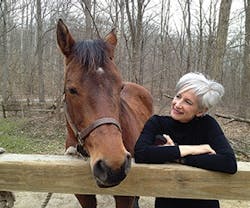The Brand Master
To make an impression, a brand has to engage people enough so that they connect with it emotionally, whether they’re the target audience or a company’s own employees. Apply this idea to design, and you can guarantee a company’s staying power—as long as it continues to resonate and inspire people.
The branding of corporate interiors can not only help make that connection, but can elevate a business to a higher plane when it’s done right. For Eileen Jones, design principal of Branded Environments at Perkins+Will, the furnishings and surfaces are only pieces of a larger puzzle.
“In today’s environment, we’re looking at how brand becomes a factor in supporting business goals and objectives, and how you look at the filter of brand as something that shapes the environment or expression of the brand,” says Jones. “It’s creating a brand that people will remember. There’s something meaningful about an organization when you have a memorable experience inside that environment. A lot of it is about storytelling, and how much of it is believable and true.”
And while it may be easy for those outside the design world to dismiss the benefits a well-branded environment can bring to an organization, it’s a reality Jones has created time and time again, whether measured in morale or repeat customers. It also helps explain why she finds herself in such high demand, especially among companies with stubborn retention problems. “I think the big thing is understanding that what we do can make a difference in people’s lives—it can make them confident about what they do or who they are within the context of an organization or corporation,” she says.
It’s an intensive way of thinking about the intersections of space, design and brand that she has championed throughout her career, and one that has been honed through an unrelenting schedule. Jones’ tenure at P+W began in 2002, shortly after the firm's acquisition of Eva Maddox Associates; in the years since, she has had the opportunity to create immersive environments for industry leaders like Haworth and INVISTA’s Antron.
WATCH: Eileen Jones and Eva Maddox talk creativity and design in NYC.
Before that, she spent 25 years doing much of the same with Eva Maddox herself—initially joining her firm on a three-month contract position. Jones developed her interdisciplinary skills by helping clients in Chicago’s Merchandise Mart create memorable showroom experiences and new identities for their brands. That included developing new marketing materials, looking at trends that impact color choices, creating new ways in which products can be experienced, and bringing new products to market.
Simply put, it was a design revolution.
“We set the bar for a different kind of interaction,” she recalls. “The whole idea of branded environments was a first in the industry of marrying design and brand to create places that spoke about brand presence, voice, attributes, benefits and message to market. Marrying those two was a real critical change in our industry.”PageBreak
These days, Jones and her team at Perkins+Will address client needs holistically. Rather than tackling projects with a design-only perspective, they view everything through an interdisciplinary lens—architecture, interior design, branded environments, planning and strategies, preservation and reuse, and urban design.
“We’re often looking for solutions that may be innovative for our customers,” she says. “I think that leads to those projects that challenge us to grow. That then is about the things that inspire me—new ideas, the relationships we build with clients over time, how we can continue to provide value and service to them, getting them to that next body or piece of work.”
“I’m inspired by nature and natural systems,” Jones adds. “When you understand the interconnectedness of those things within environmental systems, you also understand the relationship of people and groups—problem solving from a different perspective.”
Since 2003, Jones has collaborated on renovating Haworth’s One Haworth Center headquarters in Holland, Mich., and its showrooms all over the world. Their crisp and minimalist aesthetic, reconfigurability, deconstructed design elements and LEED Gold certifications all speak to Haworth’s commitment to redefining its interiors with flexible and sustainable solutions.
“That’s been a terrific model of how multiple disciplines came together in bringing a new image forth in the marketplace at a time when Haworth was reevaluating their product and nature of offering, and taking a new message to market,” she says.
Jones readily acknowledges the challenges of branding environments so deeply (“How do you make it feel fresh and new, again and again?” she asks rhetorically), but the truth is that it is a never-ending process. She holds up her work with Haworth as proof. “The fact that we continue to work with them allows us to continuously evolve that brand, and make sure the environments speak to the changes and evolution of both their brand and product.”
Consistently humble, Jones says she considers each client to be a business partner. Being able to build on those relationships and deliver a culture-changing product inspires her to keep innovating each day. And although the ideas behind branded environments are now entering the public consciousness, she continues to train her gaze on design’s horizon, looking for the next big idea that will give her clients an edge in an always-connected, super-informed world.
“It has become more critical for organizations, institutions and corporations to more clearly differentiate themselves, to give people a reason to want to come to them, whether it’s a customer or employee,” says Jones. “There’s a growing awareness of brand as a communicator and built environments as a differentiator. It’s something that can build loyalty to their brand. All of it is wrapped up in brand communication.”
